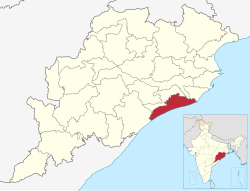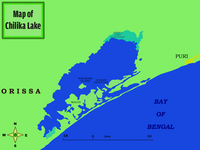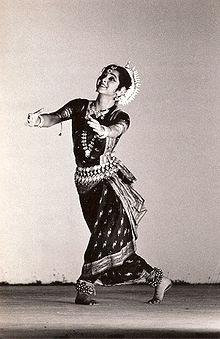
Odisha, formerly Orissa, is an Indian state located in Eastern India. It is the eighth-largest state by area, and the eleventh-largest by population, with over 41 million inhabitants. The state also has the third-largest population of Scheduled Tribes in India. It neighbours the states of Jharkhand and West Bengal to the north, Chhattisgarh to the west, and Andhra Pradesh and Telangana to the south. Odisha has a coastline of 485 kilometres (301 mi) along the Bay of Bengal in Indian Ocean. The region is also known as Utkaḷa and is mentioned by this name in India's national anthem, Jana Gana Mana. The language of Odisha is Odia, which is one of the Classical Languages of India.

Jayadeva, also spelt Jaideva, was a Sanskrit poet during the 12th century. He is most known for his epic poem Gita Govinda which concentrates on Krishna's love with the gopi, Radha, in a rite of spring. This poem, which presents the view that Radha is greater than Krishna, is considered an important text in the Bhakti movement of Hinduism.

Puri is a coastal city and a municipality in the state of Odisha in eastern India. It is the district headquarters of Puri district and is situated on the Bay of Bengal, 60 kilometres (37 mi) south of the state capital of Bhubaneswar. It is home to the 12th-century Jagannath Temple and is one of the original Char Dham pilgrimage sites for Hindus.
Ganeswarpur is an Indian village. The village falls under the Gop block of Puri District. It was founded before 1500 AD by Puri Gajapati Prataprudra Deva.
Konark is a medium town in the Puri district in the state of Odisha, India. It lies on the coast by the Bay of Bengal, 65 kilometres from the capital of the state, Bhubaneswar. It is the site of the 13th-century Sun Temple, also known as the Black Pagoda, built in black granite during the reign of Narasinghadeva-I. The temple is a World Heritage Site. The temple is now mostly in ruins, and a collection of its sculptures is housed in the Sun Temple Museum, which is run by the Archaeological Survey of India.

Khordha district is an administrative division of the state of Odisha, India. It was formed on April 1, 1993, by the division of former Puri District into Puri, Khordha and Nayagarh districts. In the year 2000 the district name was changed to Khordha. The district headquarters is Khordha Town. The capital city of Bhubaneswar is located in this district. Khordha is the most urbanized of all the districts of Odisha.
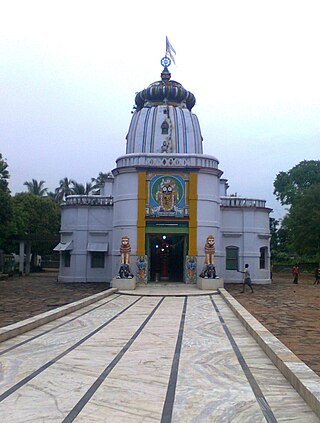
Nayagarh is both a town and the municipality headquarters of the Nayagarh district in the Indian state of Odisha.
The Odia (ଓଡ଼ିଆ), formerly spelled Oriya, are an Indo-Aryan ethnic group native to the Indian state of Odisha who speak the Odia language. They constitute a majority in the eastern coastal state, with significant minority populations existing in the neighboring states of Andhra Pradesh, Chhattisgarh, Jharkhand and West Bengal.
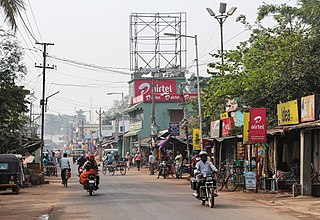
Pipili is a town and a NAC under jurisdiction of Puri district in the Indian state of Odisha. It is famous for designing beautiful Applique handicrafts. It is a town of artisans famous for their colourful fabrics.

Ramachandi Temple is located at a spot on the banks of the Kusabhadra River where it flows into the Bay of Bengal. It is only 5 km away from Konark in the Puri District of Odisha, India. Goddess Ramachandi, the deity of Konark is thought by some to be the presiding deity of this temple, while others thought it to be the temple of Mayadevi, wife of Surya.
Odisha is one of the 28 states of India, located on the eastern coast. It is surrounded by the states of West Bengal to the northeast, Jharkhand to the north, Chhattisgarh to the west and northwest, and Andhra Pradesh to the south and southwest. Odia is the official and most widely spoken language, spoken by 33.2 million according to the 2001 Census. The modern state of Odisha was established on 1 April 1936, as a province in British India, and consisted predominantly of Odia-speaking regions. April 1 is celebrated as Odisha Day.
Tourism in Odisha is one of the main contributors to the economy of Odisha, India, with a 500 km (310 mi) long coastline, mountains, lakes, natural biodiversity and rivers. Odisha is a major tourist destination in India, with various tourist attractions, including wildlife reserves, beaches, temples, monuments, the arts and festivals. Other than wildlife reserves, beaches, temples, monuments, the arts and festivals, the Odisha Tourism Development Corporation, a public sector undertaking of the Government of Odisha, is also developing the tourism sector of Odisha and India.
The Indian state of Odisha has a rich cultural and artistic heritage. Due to the reign of many different rulers in the past, arts and crafts in Odisha underwent many changes giving an artistic diversity today in the forms of traditional handicrafts, painting and carving, dance and music, clothing, etc.

Odissi music is a genre of classical music in India, originated from the eastern state of Odisha. The traditional ritual music for the service of Lord Jagannatha, Odissi music has a history spanning over two thousand years, authentic sangita-shastras or treatises, unique Ragas & Talas and a distinctive style of rendition.

Raj-Ranpur is a small town in the district of Nayagarh in the eastern Indian state of Odisha. The town is also known as Ranpurgarh or simply Ranpur as per the modern usage. The town is historically significant especially during the British Raj when it was the capital of the princely state of Ranpur. The martyrs Shaheed Raghu-Dibakar who were hanged for their resistance to British rule belong to this place. Rajsunakhala and Tangi are the nearest Town of Raj-Ranpur, which in almost 10 to 20 km from the town. Rajsunakhala is the most important business centre in Ranpur block under Nayagarh district.

Konark Dance Festival is a five-day dance festival held every year in the month of December mostly from 1 to 5 in backdrop of the Sun temple in Konark, Odisha in India. It is one of the biggest dance festivals held in Odisha.
Gop is a town and a NAC under jurisdiction of Puri district in the Indian state of Odisha.
Kuakhai River is a distributary of Mahanadi River which flows by Bhubaneswar, Odisha. Mahanadi River branches off at Naraj, Cuttack as Kathajodi River, then immediately it is bifurcated, with its southern branch flowing as Kuakhai River. The Kushabhadra River branches off from the Kuakhai River Gandarpur, Balianta and flows in a south-western direction towards Nimapara and Gop into Bay of Bengal. The Daya River starts as a branch of the Kuakhai River at Saradeipur and is then joined by the Malaguni River below Golabai and flows through Khordha and Puri districts before emptying into the north-eastern corner of Chilika Lake. Most of the water supply of Bhubaneswar is met by the Kuakhai river, along with Daya River.

Mahari is a ritualistic dance forms form the eastern Indian state of Odisha that used to be performed at the temple of Lord Jagannatha at Puri by devadasi dancers called mahari. Following the abolition of the devadasi system, the dance has been discontinued at the Jagannatha Temple but is now performed on stage at many venues. The Mahari dance spurred the development of both Odissi and the Gotipua dance forms of Odisha. The Maharis have been among the foremost exponents of both traditional Odia dance and Odissi music.
Parikud is an island in Chilika Lake, Odisha, India. The land mass is spread over 97 mouzas of Krushnaprasad panchayat samiti. It is surrounded by Chilika Lake and the Bay of Bengal on two sides. The settlement Jahnikuda is located at the easternmost end of the island and acts as an access point to Puri. The residents of this area primarily work in agriculture and fishing. The current head of the island is Raja Santosh Chandra Deo.
